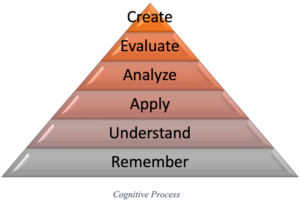Johns Hopkins UniversityEst. 1876
America’s First Research University
A learning objective is student centric; it states what the student will learn and be able to accomplish by the end of instruction. It describes a specific behavior which will lead to the desired goal. It is specific and measurable. It has three major components:
Learning objectives emphasize:
Learning objectives do not emphasize:
Specific – Statement of learning are concise and well defined in describing what students will be able to do.
Measurable – Use action / measurable verbs that can be observed through any assessment such as test, homework, or project etc. to describe what the student will be able to do. (see list attached to this document).
Attainable – Ensure that students will have the pre-requisite knowledge by the end of the course in able to achieve the stated learning objectives.
Relevant – The stated skills or knowledge are appropriate for the program and the course as described in the curriculum.
Time-bound – State when students should be able to demonstrate the knowledge or skill (mid or end of course or end of program, etc.).
Follow Bloom’s Taxonomy cognitive process to state your learning objectives. Ensure that the stated objectives describe a progressive cognitive process that represents a continuum of increasing cognitive complexity.

On a continuum of learning, students start by:
Remembering – recalling previous knowledge.
Understanding – understanding new information and presenting it in their own words.
Applying – applying what they learned into authentic settings.
Analyzing – distinguishing between facts and inferences and recognizing logical fallacies in reasoning.
Evaluating – making judgment about ideas, materials or values.
Creating – putting the parts learned together to create a whole, with a focus on creating meaning or structure.
(Bloom’s/Anderson & Krathwohl’s Taxonomy – Cognitive Domain)
| Remember Recall facts and basic concepts Define Identify List Name Recall Recognize Record Relate Repeat Underline |
Understand Explain ideas and concepts Choose Cite Demonstrate Describe Determine Differentiate Discriminate Discuss Explain Express Give Identify Interpret Locate Pick Practice Report Respond Restate Review Recognize Select Simulate Tell Translate |
Apply Use information in new situations Apply Demonstrate Dramatize Employ Generalize Illustrate Initiate Interpret Operate Operationalize Practice Relate Schedule Shop Use Utilize |
Analyze Draw connections among ideas Analyze Appraise Calculate Categorize Compare Conclude Contrast Correlate Criticize Deduce Debate Detect Determine Develop Diagram Diagnose Differentiate Distinguish Draw conclusion Estimate Evaluate Examine Experiment Identify Infer Inspect Inventory Predict Question Relate Solve Test |
Evaluate Justify a stand or decision Appraise Assess Choose Compare Critique Estimate Evaluate Judge Measure Rate Revise Score Select Test Validate Value |
Create Produce new or original work Arrange Assemble Collect Compose Construct Create Design Develop Devise Formulate Manage Modify Organize Plan Prepare Produce Propose Predict Reconstruct Set-up Synthesize Systematize |
Anderson, L.W., & Krathwohl (Eds.). (2001). A Taxonomy for Learning, Teaching, and Assessing: A Revision of Bloom’s Taxonomy of Educational Objectives. New York: Longman.
Bloom, B.S. and Krathwohl, D. R. (1956). Taxonomy of Educational Objectives: The Classification of Educational Goals, by a committee of college and university examiners. Handbook I: Cognitive Domain. NY, NY: Longmans, Green.
Office of the Provost
265 Garland Hall
3400 North Charles Street
Baltimore, Maryland 21218
Phone: (410) 516-8070
Fax: (410) 516-8035
[email protected]
